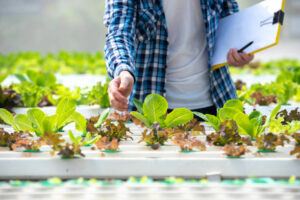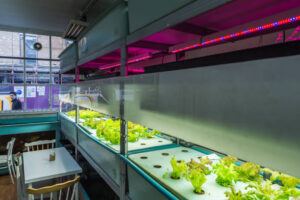Aquaponics might sound complex at first, but I assure you, the concept is fascinating and straightforward. This innovative farming method combines aquaculture, the raising of fish, with hydroponics, the process of growing plants without soil. Together, they form an environmentally friendly and efficient system that can change the way we approach food production.

At the heart of an aquaponics system is a harmonious symbiotic relationship. It’s a closed-loop ecosystem where the waste produced by fish supplies nutrients for the plants. In return, plants clean the water, which is then recirculated back to the fish tanks. It’s nature’s own recycling operation in action.
So, what exactly makes up an aquaponics system? Three main components are essential: the fish tank, grow beds where the plants live, and a water pump to keep everything moving. Beneficial bacteria also play a starring role by converting ammonia from fish waste into nitrates, a form of nitrogen that plants can use to grow.
Understanding the different types of aquaponics systems can help you choose the right one for your needs. Media-based systems are beginner-friendly, employing gravel or clay pellets to support plant growth. Nutrient film technique (NFT) systems use a thin film of water to deliver nutrients, making them suitable for plants with small root systems. Deep water culture systems, where plant roots are suspended in nutrient-rich water, are ideal for leafy greens.
Why does this matter for you? Aquaponics is not just a clever way to grow food; it provides a sustainable and scalable model that could significantly reduce the environmental impact of traditional farming. Not to mention, it can be implemented in a variety of settings, from a backyard greenhouse to large-scale commercial operations.

Aquaponics and the Economy: A Sustainable Growth Perspective
Aquaponics stands out as a symbol of sustainable agriculture and its influence on the economy is undeniable. As a self-contained ecosystem, it provides a remarkable method for producing food that uses a fraction of the water required by traditional farming. This aspect alone has tremendous implications for water conservation, a major environmental concern.
On a community scale, aquaponics farms can be established within city limits, reducing the need for transportation and thus, slashing the carbon footprint associated with food distribution. Local food production not only ensures fresh, nutrient-rich produce but also brings a new dimension to food security in areas that lack arable land.
The growth of the aquaponics industry opens up new avenues for employment, from construction and maintenance of aquaponics systems to marketing and distribution of produce. It promotes local economies by fueling small business growth, especially in urban and peri-urban areas, where space is often underutilized. Entrepreneurs have the opportunity to capitalize on the increasing demand for organic and locally sourced foods.
Education plays a pivotal role in the expansion of aquaponics. As more people understand the technology and learn how to manage these systems, communities see the rise of grassroots movements that take control of local food production, leading to economic revitalization and inclusive workforce development.
Looking forward, aquaponics is positioned to tackle some of our world’s most pressing issues, including hunger, water scarcity, and the consequences of climate change. The potential challenges include regulatory hurdles, initial capital investment, and market acceptance. However, the industry continues to innovate, ensuring that aquaponics remains at the forefront of sustainable economic growth.